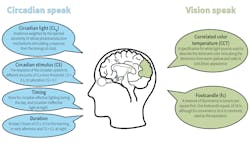Creating the circadian lighting toolbox — Bringing the language into practice (MAGAZINE)
Throughout this series on circadian lighting, we have outlined the need for a new lighting language, analyzed varying LED spectra to determine the variation in light level needed to reach a target circadian stimulus (CS) value of 0.3, and examined the different neural mechanisms in the eye that cause a light source to fall on either the warm spectral response of the circadian system, or the cool side.
At this point, you may have grown a little weary of the complexities of circadian-effective light. Though this information may not seem directly relevant to a specifier or lighting design practice, it is important that all lighting professionals be aware of the foundational science behind light’s impact on human health. Let’s recap some key takeaways from this series.
- In the 20th century, footcandles (fc) and correlated color temperature (CCT) worked well to describe the amount and quality of light for vision. Now, with the advancements in LED technology and research into circadian rhythms, a new lighting language must be adopted to describe the impact of light on health.
- Light stimulates five different types of photoreceptors in the retina, each with a different range of overlapping spectral sensitivities. Neurons in the retina combine signals from these photoreceptors, which are then sent to different parts of the brain associated with the visual and the circadian systems.
- The intrinsically photosensitive retinal ganglion cell (ipRGC) type is essential for light-activation of the circadian system.
- Color vision represents one of the many ways that the visual system combines the three types of cone photoreceptor responses. The long-wavelength (L) and medium-wavelength (M) sensitive cone signals combine in the retina to form the spectral opponent red versus green (r-g) color channel, whereas the short-wavelength (S) sensitive cone combines with the L and M cones to form the second, blue versus yellow (b-y) color channel in the retina. The human circadian system also utilizes this b-y color channel formed in the retina.
- Depending upon the balance between signals from the S cone and from the L+M cones to the b-y channel, white light sources can appear either “warm” (yellowish white) or “cool” (bluish white).
- For “warm” sources, the human circadian system sensitivity to light is dominated by the ipRGC response. For “cool” sources, the ipRGC response is combined with the “blue” signal from the b-y color channel to stimulate the human circadian system. When determining a source’s effect on the circadian system, its spectrum will be weighted by either the “warm” or the “cool” sensitivity curve.
- Subadditivity is demonstrated when more light is added to a “cool” source that reduces the “blue” signal from the b-y color channel to the ipRGC.
- The amount of light falling on the retina (vertical illuminance, EV) is critical for entrainment of the circadian system. The circadian system needs bright days and dark nights to synchronize physiology and behavior with the sunrise and sunset.
- A new vocabulary — including CLA (circadian light), which represents the spectral sensitivity of the circadian system, and CS (circadian stimulus), which represents the absolute response of the circadian system to light — must be adopted so we can quantify the impact of the lit environment on the human circadian system. CCT and footcandles are not substitutes for these new metrics.
- LEDs have the potential to provide both good visibility and good health as long as the appropriate metrics are employed.
Translating into practice
Now, let’s boil it all down. First, for the visual system, CCT is good way to describe the tint of white light sources as “cool” or “warm,” and footcandles (or lux) are a good way to describe the amount of light for foveal tasks such as reading. Second, CLA and CS are appropriate to describe the spectral and absolute sensitivities of the human circadian system. Together with the duration and timing of circadian-effective light exposure, it is possible to describe circadian entrainment and thereby healthy lighting.
To get a cost-effective and energy-efficient lighting design, we need to use the right language and the right metrics. Specifiers and lighting designers are already familiar with CCT and footcandles as they relate to the visual system, but it will take some practice with CLA and CS as they affect the circadian system. The goal for circadian entrainment is to provide bright days and dark nights. Bright days are defined as CS ≥ 0.3 (combination of spectrum and light level at the eye) for a minimum duration of 2 hours, ideally in the morning, day after day, while dark nights are defined as CS < 0.1 in the home.
To achieve a CS ≥ 0.3 during the day, first consider local lighting on the desk or behind the computer screen. This will be the most energy-efficient way to deliver circadian-effective light at the lowest cost. The Lighting Research Center (LRC) has used this approach successfully in several different settings (Fig. 1).
Typical lighting designs in homes and offices are almost always below the CS > 0.3 target, so people are usually left in what is known as biological darkness. A simple way for people to add circadian-effective lighting to their own space is to create a DIY luminaire as shown in a video developed by the LRC.
If circadian-effective lighting must be delivered from the ceiling due to other design constraints, use white light of any particular tint (warm, neutral, or cool) that serves the aesthetic purpose of the space. Any white light will do, but remember that varying spectra impact the circadian system differently, so calculations will need to be done.
Delivering the dose
To get the most energy-efficient solutions, use UL DG 24480 for guidance. You will need to begin with modeling the space in commercially-available, photometrically-realistic software. Once the space has been modeled, you can test a lighting design by inserting IES (*.ies) files of the light source to obtain vertical illuminance levels (EV) at the presumed location of the occupants’ eyes. If occupant location is unknown or dynamic, create a grid of vertical illuminance points throughout the space, and target an average CS of 0.4 to assure 0.3 is met in most locations throughout the space.
From the average value of EV and the relative SPD of the light source from the manufacturer, you can use the freely available CS Calculator provided by the LRC to determine whether the lighting design provides a CS ≥ 0.3 (Fig. 2). If not, a new luminaire type, wall/ceiling reflectance, or SPD can be substituted, or simply add more luminaires. Compute EV again (and again) to determine if the CS target has been met, and be cognizant of glare.
The collaboration between researchers, designers, specifiers, and manufacturers will be key to the integration of circadian-effective lighting into the built environment (Fig. 3). Since CS is application-based, designers need to know how much light gets to the eye along with its spectrum, so consider the importance and benefit of sharing a source’s spectral information.
FIG. 4. To specify a dose of healthy lighting, the SPD and the photopic illuminance at the eye (EV) must be known (unique combination calculates a CS value) along with the duration of circadian-effective light exposure.
Think of healthy lighting as a dose, which is the product of amount (CS) and duration (hours) (Fig. 4). Here, controls can be important because only a minimum of 2 hours of CS ≥ 0.3 — ideally in the morning — is needed during the day, and light levels can be dimmed, especially in the evening hours. Suggested CS schedules can vary based on design goals, so adjust schedules accordingly.
It is important that specifiers and lighting designers remind their clients that night-time light exposure is just as important as daytime light exposure. For example, when used excessively at night a self-luminous tablet can disrupt the circadian system, undoing the beneficial effects from bright light during the day. At night, use conventional domestic lighting but do not use tablets or phones for more than 1 hour in the evening.
Inspiring the future
Before we lived and worked in buildings both day and night, we exercised, ate a balanced diet, and were up with the sun and in bed all night. Although modern society has become more attuned to the idea that we need to return to our former lifestyle by exercising and eating a more modest diet, the third characteristic of a balanced life — exposure to circadian-effective light during the day and circadian-ineffective light at night — is not widely understood or appreciated. Lighting professionals have a duty to actively and publicly promote bright days and dark nights for a balanced lifestyle. Thanks to science and technology, we can now do this in an energy-efficient and cost-effective way by designing lighting to support human needs in built environments. All we need to move forward is the adoption of the appropriate language and metrics, education on the health impacts of lighting, and creative design options to achieve these goals. ♦
Factor individuals into the lighting equation
It should be noted that although it is a simple concept of creating a robust light-dark 24-hour cycle with bright days and dark nights, there are limitations to saying a specific light stimulation, or dose (brightness, spectrum, time, and duration of exposure), will always provide the same circadian effect for every person. This could be due to photic history (what light you’ve received in the past), or unexplored areas such as genetic impact, adaptation to geographical location (long nights in winter and long days in summer), or variations in sensitivity to circadian light among the population.
So with all these individual differences, how do we get each person on track? More research needs to be done in these unexplored areas, but the key really is to provide a robust schedule of bright light (greater than or equal to a calculated 0.3 CS) during the day and dim light (less than a calculated 0.1 CS) at night, while tailoring the timing to particular needs.
Think of the concept like recommending a flu shot. The vaccine may not have the same impact on every person, but that doesn’t mean we shouldn’t provide this solution to reduce as many cases as possible. Similarly, there may be other factors contributing to why an individual may not be sleeping well, but we should still provide bright light during the day to promote circadian entrainment to those who are not sleeping well at night.
Tracking a person’s light exposure and adjusting personal lighting devices would be a good solution for circadian entrainment of an individual. Creating a healthy circadian lifestyle is important to maintain general health, but especially for those predisposed to certain diseases or cancers. Although circadian disruption may not directly cause diseases, perhaps, as Mark Rea of the Lighting Research Center has noted, circadian disruption presumably can reveal genetic frailties.
Get to know our expert
ALLISON THAYER, MS, BA, is a research specialist who was with the Lighting Research Center (LRC) at Rensselaer Polytechnic Institute (RPI) at the time of this writing. She has joined the recently established Light and Health Research Center at Mount Sinai Hospital Icahn School of Medicine. Thayer holds a bachelor’s in architecture, and a master’s of science with a concentration in lighting from RPI. Thayer has played a main role in the development of the structure and content of the Healthy Living website for the LRC.
For up-to-the-minute LED and SSL updates, why not follow us on Twitter? You’ll find curated content and commentary, as well as information on industry events, webcasts, and surveys on our LinkedIn Company Page and our Facebook page.






![The DesignLights Consortium continues to make progress in shifting outdoor lighting products and implementation practices toward a more restrained and thoughtful strategy. [Image does not represent a DLC qualified fixture.] The DesignLights Consortium continues to make progress in shifting outdoor lighting products and implementation practices toward a more restrained and thoughtful strategy. [Image does not represent a DLC qualified fixture.]](https://img.ledsmagazine.com/files/base/ebm/leds/image/2024/08/66be810888ae93f656446f61-dreamstime_m_265700653.png?auto=format,compress&fit=&q=45&h=139&height=139&w=250&width=250)


